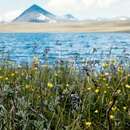en
names in breadcrumbs


Polemonium, commonly called Jacob's ladders or Jacob's-ladders (the name derived from the Biblical story), is a genus of between 25 and 40 species of flowering plants in the family Polemoniaceae, native to cool temperate to arctic regions of the Northern Hemisphere.[1][2] One species also occurs in the southern Andes in South America. Many of the species grow at high altitudes, in mountainous areas. Most of the uncertainty in the number of species relates to those in Eurasia, many of which have been synonymized with Polemonium caeruleum.[3]
Polemonium are perennial plants (rarely annual plants) growing 10–120 cm tall with bright green leaves divided into lance-shaped leaflets. They produce blue (rarely white or pink) flowers in the spring and summer.
Some species are used as food plants by the larvae of some Lepidoptera species including Coleophora polemoniella.
As of April 2020 Kew's Plants of the World Online accepts 37 species.[1] Many are locally known simply as "Jacob's ladder".[4][5][6][7]
Polemonium, commonly called Jacob's ladders or Jacob's-ladders (the name derived from the Biblical story), is a genus of between 25 and 40 species of flowering plants in the family Polemoniaceae, native to cool temperate to arctic regions of the Northern Hemisphere. One species also occurs in the southern Andes in South America. Many of the species grow at high altitudes, in mountainous areas. Most of the uncertainty in the number of species relates to those in Eurasia, many of which have been synonymized with Polemonium caeruleum.
Polemonium are perennial plants (rarely annual plants) growing 10–120 cm tall with bright green leaves divided into lance-shaped leaflets. They produce blue (rarely white or pink) flowers in the spring and summer.
Some species are used as food plants by the larvae of some Lepidoptera species including Coleophora polemoniella.